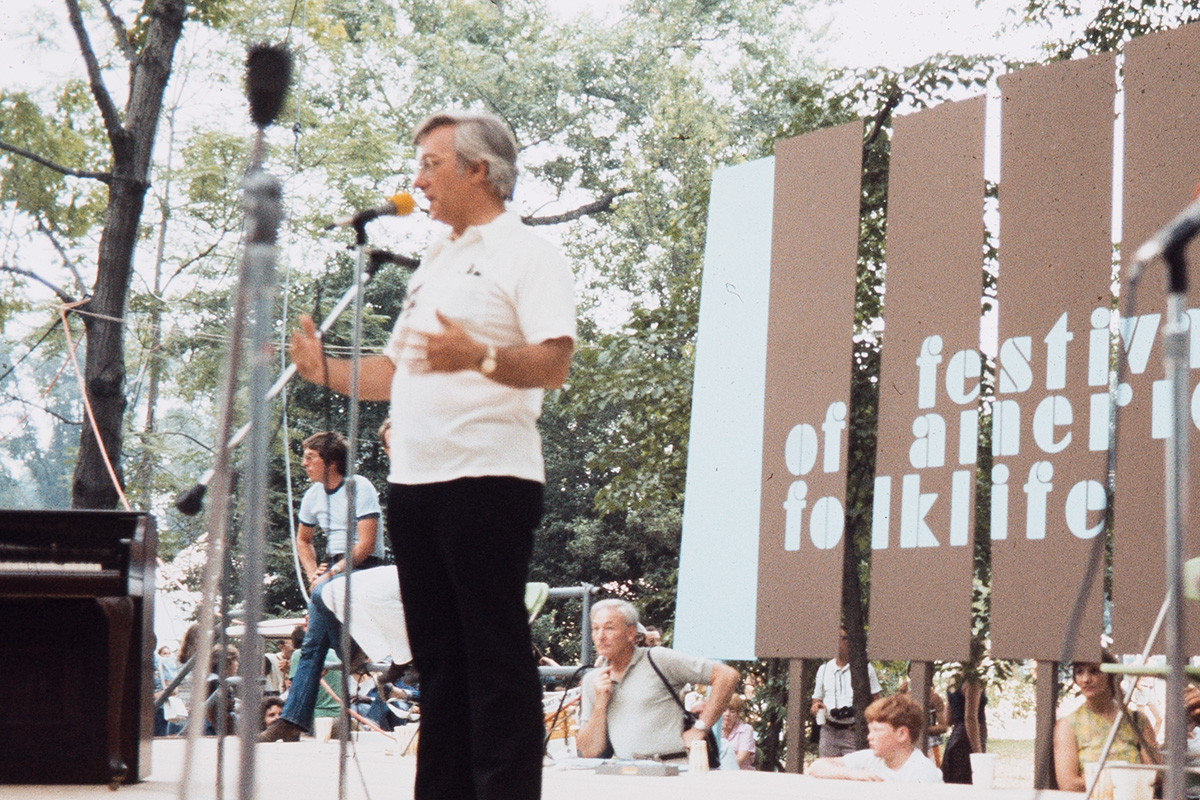Remembering Jim Morris, Festival Co-Founder

Jim Morris at the 1974 Festival, then known as the Festival of American Folklife. Photo by Reed & Susan Erskine, Ralph Rinzler Folklife Archives
James R. Morris, co-founder of the Smithsonian Folklife Festival, passed away on July 22. I had the privilege of working for and with Jim during the Bicentennial Festival in 1976, when I first started at the Smithsonian.
Morris had a storied life as a singer, actor, conductor, producer, and arts and culture advocate. His creativity was irrepressible, and his tenure at the Smithsonian was appropriately summed up by the title of his 2011 memoir, Smithsonian Impresario. Even now, as the Smithsonian is better known for employing curators, collection managers, and conservators, the job title of “impresario” would raise eyebrows here and in the broader museum world; just imagine how it was in the 1960s. Morris was hired by then-Secretary S. Dillon Ripley, who amid the profoundly coupled social upheaval and optimism of the 1960s, saw the need for somewhat stodgy and dusty museums to become more engaging, inclusive, people-connected places. Morris did this through the founding of benchmark performing arts programs at the institution.
In 1967, Ripley appointed Morris as the founding director of the Smithsonian’s Division of Performing Arts. Having produced the American Folk Festival in Asheville, North Carolina, in 1965 and 1966, Morris developed the idea of producing a folk festival on the National Mall. The Asheville Festival was a theatrically staged performance which included Pete Seeger and Alan Lomax. When Morris joined the Smithsonian and pursued the idea of a folk festival, he took Lomax’s recommendation and hired Ralph Rinzler to direct it and include more grassroots, community-based musicians. The first Festival of American Folklife was four days-long and took place over the Fourth of July weekend on the Mall and on the plaza of the Museum of History and Technology (now the National Museum of American History). It drew some 400,000 visitors, strong media attention, and kudos from members of Congress. Critics questioned the seriousness of the Festival and its use of the Mall, but Morris persisted, and the Festival became an annual event.

As the American Bicentennial loomed, the Festival became one of its key national components, symbolizing the scope of American grassroots creativity and its connections to cultures from around the world. In the years leading up to 1976, the Festival’s budget and staff grew under Morris’ guidance. Programs on the African Diaspora, Old Ways in the New World, Working Americans, Native Americans, and Regional America were developed and employed a diversity of younger cultural scholar-activists who went on to make profound contributions in arts and humanities, ethnic and regional studies, African American and Native American programs. The 1976 Festival lasted three months, had a budget of over $9 million, and involved some 5,000 artists from every region in the United States and from 35 other nations. It also had a touring component, whereby participants in the Festival would tour various cities across the United States. Morris and Rinzler shared the honor of Washingtonian of the Year.
For Morris, the Festival helped affirm the idea of a rich and vital American culture. It was a corrective to notions of American cultural insecurity, or feelings that Americans to be cultured had to imitate European “high” art forms.
Morris’s cultural interests were broader than the Festival, and after the 1976 Bicentennial, he and Rinzler parted ways. As the director of the Division of Performing Arts until its dissolution in 1985, Morris hired amazingly talented and productive colleagues, Jim Weaver, Bernice Johnson Reagon, Dwight Blocker Bowers, and Ken Slowik among them. He initiated the critically acclaimed Smithsonian Collection of Recordings, the Discovery Theater for school children, and various performance programs in jazz, American dance, and musical theater. He was nominated for a Grammy Award for his annotation of American Popular Song, and the truly seminal, Grammy-winning Smithsonian Collection of Classic Jazz was produced under his leadership. The music program in culture history at the National Museum of American History owes much to his work.
Jim’s creative energy extended beyond the Smithsonian. He taught singing, performed, wrote scripts, produced recordings and even when retired served as a museum volunteer from his home base in Virginia’s Shenandoah Valley. Morris participated in a Smithsonian Associates program in 2012 following the publication of his book, and, in 2017, appeared on a Festival stage for its fiftieth anniversary, providing his perspective on what it had achieved.
Jim Morris is survived by a loving family and his wife of four decades, Cynthia Hightower Morris, who had also worked for the Festival.

Richard Kurin is the Smithsonian’s Distinguished Scholar and Ambassador at Large. He served for more than a decade as the Smithsonian’s Under Secretary and for some two decades before that as the director of the Center for Folklife and Cultural Heritage.

